Samtec’s corporate headquarters, in New Albany, Indiana, in the heart of Silicon Prairie, underwent a major expansion in 2017. This included a total renovation of the lobby. The original lobby was small with a few chairs that reflected the mindset of the company in its earlier days: hard-working, functional, and definitely not extravagant.
The new lobby was reimagined into a spacious, modern, two-story welcome center that reflects the innovative, leading-edge technology company that Samtec has become. Wood and stone décor, with floor-to-ceiling windows welcome guests with abundant light, charm and warmth.
The centerpiece of the lobby area is the Samtec aquarium. It grabs your attention, it’s peaceful, and besides, we couldn’t put a live tiger in the lobby.
The Samtec aquarium was designed and built by Acrylic Tank Manufacturing, of Las Vegas, Nevada. You may recognize their name from the TV show “Tanked” on Animal Planet. If you’re not familiar with Tanked, it’s a cross between Pawn Stars, Duck Dynasty and The Undersea World of Jacques Cousteau.
The design, construction, and installation of the aquarium are featured on an episode of Tanked. You can find it online if you google “Tanked Samtec Shark Byte” (here’s a synopsis of the episode).
Personally, I had a ton of questions about the aquarium. Questions like what types of fish are these, what do they eat, how long do they live, how does the lighting work, how do we keep them healthy, etc., etc.? I spoke to Chris Schickel, who oversees the aquarium’s maintenance and the fish’s wellbeing.
Here’s a summary of my conversation with Chris:
Size and Filtration Systems
The tank holds 6,000 gallons of water (22,712 liters), and at all times there’s another 500 gallons passing through the filtration system under it. Four pumps each cycle 8,500 gallons per hour, for a total of 34,000 gallons cycled per hour.
The filtration system consists of two biological filters, the purpose of which is to grow bacteria, to lower ammonia, thereby reducing nitrites and nitrates and other toxins from building up in the tank. Two mechanical filters collect waste, debris, and other biologic elements (nasties). Two pumps in an adjacent room cycle water through a sand filter, and another pump sends the water through chilling units to maintain the 74° F (23° C) water temperature.
While I usually think of protein as a good thing, that’s not the case with aquariums. Protein skimmers inject air into the filters, creating small bubbles. Proteins attach to the bubbles, and when they burst, protein levels are reduced.
The tank is 21’ (6.4 meters) long, 6’ (1.8 meters) wide, and 6’ (1.8 meters) tall. It’s made of 3” (7.6 cm) thick acrylic. Acrylic is much lighter and stronger than glass. Acrylic will last a lifetime and is clear. Glass discolors, and the thicker the glass, the harder it is to see through. Iron is more visible in thick glass, and the glass appears to have a green tint.
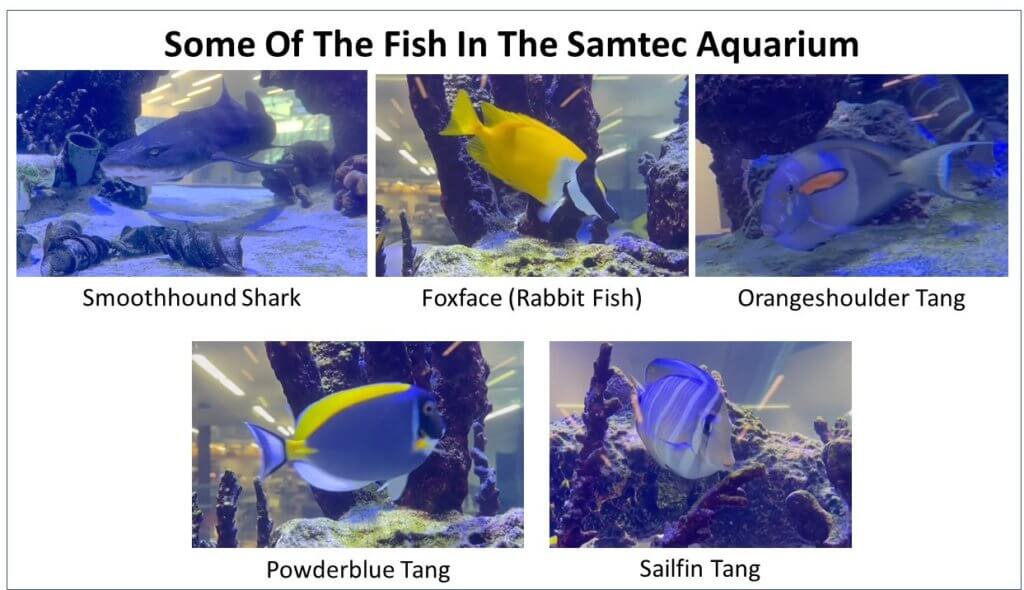
The Fish
I asked Chris why these fish were selected for the Samtec aquarium. Chris explained that they were strategically selected to coexist. That’s aquarist code for they won’t eat each other. In the case of our aquarium, since we knew we wanted sharks, the other fish were selected because they can live and survive with sharks.
For example, all of the other fish are too big to be eaten by sharks, and they are not overly-aggressive by nature, so they won’t attack each other or the sharks.
They are saltwater fish, mostly from the Indo-Pacific region, but some are native to the U.S. coastal waters off the Atlantic and Pacific coasts. For example, the sting ray is a California Sting Ray, and the sharks — Horn Sharks and Smoothound Sharks – are also caught off the coast of California.
How are the fish caught? Or are they bred somewhere? Many are still caught in the wild. Divers collect the fish with nets. Most saltwater fish are found in coral reefs.
Chris explained that collecting these types of fish has become much more responsible and ecologically-friendly. The industry is now more regulated, permits and licenses are required to harvest, and there are limits on the number of fish that can be harvested. Chris explained that “the industry is very responsible and careful, and they help to maintain and grow the population.”
Technology advances now allow more fish to come from captive breeding and fewer are taken from the ocean.
You may have noticed the brown corkscrew objects on the bottom of the Samtec aquarium floor, in the picture (above) of Smoothhound shark? Those are shark eggs. Several months ago one of the Horn Sharks laid about a dozen eggs, but they were not fertilized and therefore never hatched. Apparently, this isn’t unusual for a young female shark when she lays eggs for the first time. But we have at least two new eggs in the aquarium, and Chris is watching them to see if they’re fertilized. Instead of spring chickens we’ll have spring sharks. Shark eggs have about a 6-8 month gestation period.
The smaller fish in our aquarium have a life expectancy of 12-15 years, while the sharks can live up to 25 years or more.
The sharks mainly eat squid, krill, and silversides (a saltwater minnow). The sharks are fed three days a week. All of the other fish daily are fed pellets through an automatic feeder. On the days sharks are fed, the other fish also get Mysis Shrimp and Brine Shrimp.
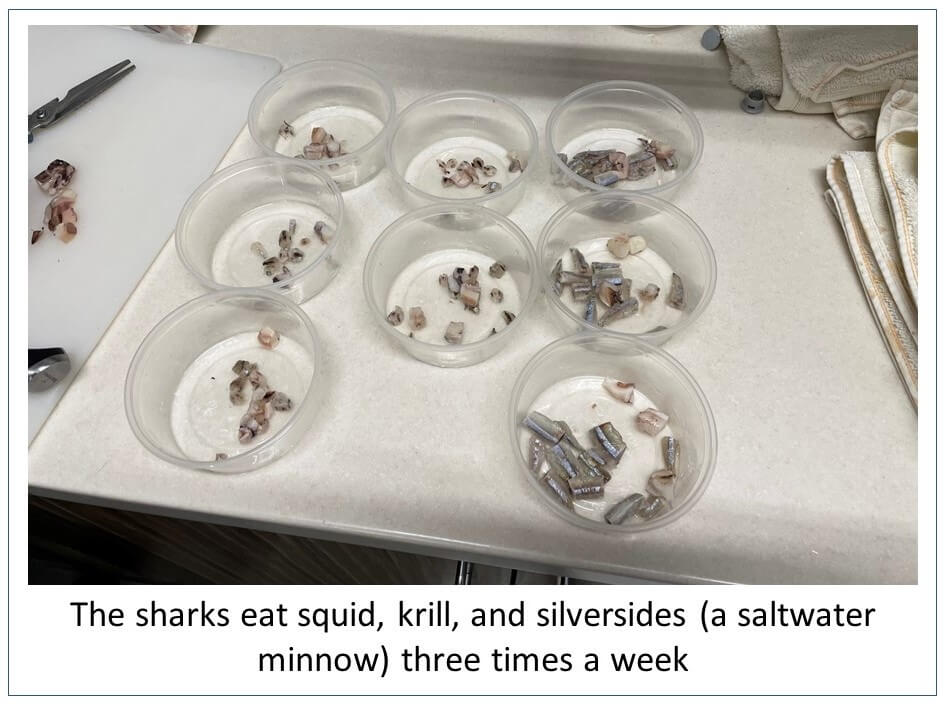
Is there a size limit for fish in this size aquarium? The fish in the Samtec aquarium will not outgrow the tank. For this size tank, six feet is about the maximum length. The biggest fish in our tank are the Smoothhound Sharks, which are about 4’ long, and may grow another 1 to 2 feet.
Lighting
The Samtec aquarium has an automated lighting system.The white lights are on during the daytime, from 9:00 am – 4:00 pm. Blue lights are on for one hour in the morning, from 8:00 – 9:00 am, and then for one hour at the end of the day, from 4:00 – 5:00 pm. Fish don’t need any more light, and too much light promotes algae growth in the aquarium.
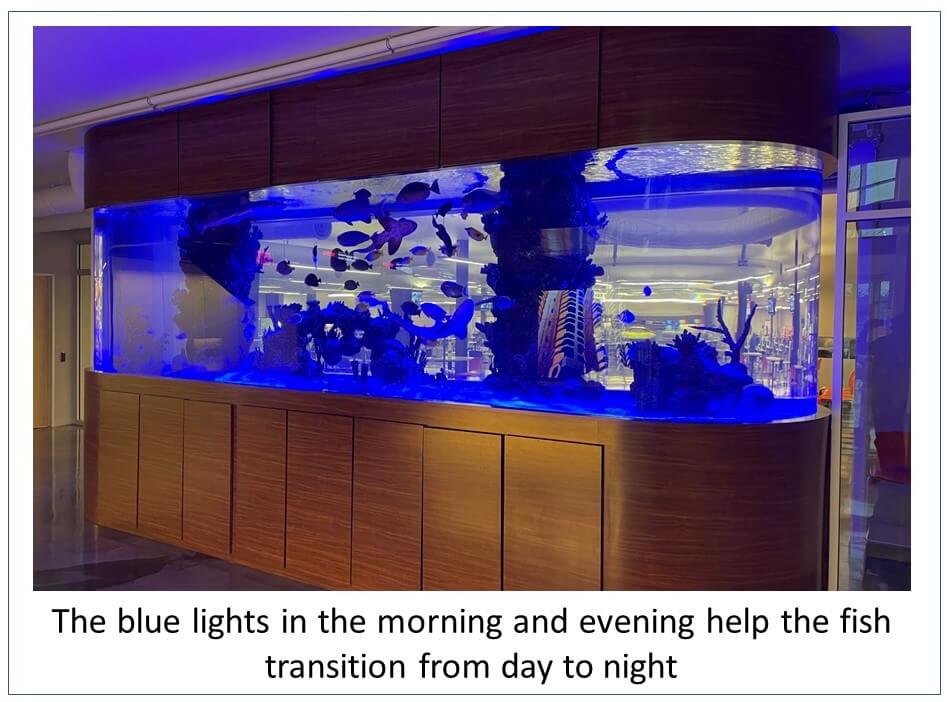
Shades descend at night because, like us, fish need rest. Lights and movement in the building make it difficult for them to rest, and protecting them from these types of distractions maintains their wellbeing.
Do fish sleep? Fish go into a state of resting, behind plants, in sandy areas, behind rocks, and in safe places, but they don’t fall asleep like humans. Chris explained that they rest and their metabolism slows down, but they don’t actually lose consciousness.
I hope you enjoyed reading about another facet of life at Samtec that is seldom seen, except by our associates and visitors. Next week I’ll go back to writing about connectors, product demonstrations, ways to improve quality, etc.
In the video: Music by Maarten Schellekens. Song title “Ethereal Meditation” Attribution-NonCommercial 4.0 International (CC BY-NC 4.0) No changes were made.
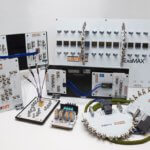
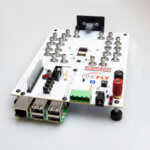

Love the tank! Very good replacement for the tiger.